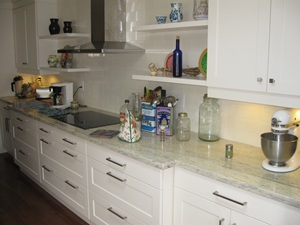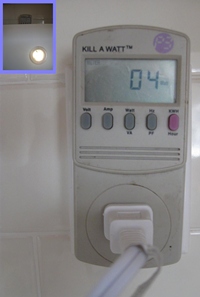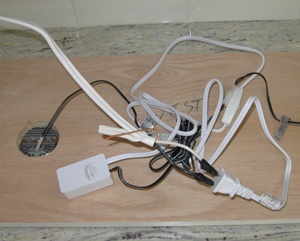Light your kitchen counters for pennies a month!
Are LED under cabinet lights ready for prime time? As I say in LED house lights, most household LED lights are not yet bright or reliable or cheap enough to justify converting your existing incandescent or fluorescent lights to LEDs. (I said that over two years ago and it still holds true in early 2011!) I bought some GU10 replacement LED lights a few months back for a basement stairwell, and while they work reasonably well and my wife hasn’t complained about how dim they are, they provide barely enough light to find one’s way downstairs in the dark, nowhere near what you’d want to provide pleasant room lighting.
Fortunately, LED under cabinet lights seem to be overcoming at least two of the three barriers to widespread adoption – brightness and reliability – and prices are starting to drop as well. When we redid our kitchen, the kitchen designer insisted that LED under cabinet lights wouldn’t look good – not bright enough, too cold or blue a light, unreliable. But I insisted on LED lights, sourced some myself, and actually installed them myself once the installer had drilled puck light holes in the valence covers, and my wife and I have been very pleased with the result. These LED under cabinet lights provide a bright, natural (warm) white color, and give good task lighting to specific areas of the kitchen for so little energy it’s not even worth mentioning! (OK, I will mention it, later on!)

LED under cabinet lights brighten our new granite countertops
First, take a look at this shot of our kitchen cabinets with the LED under cabinet lights turned on. As you can see, these lights provide a nice warm color – closer to yellow than blue – which is more than you can say of most LED lights available today. The vast majority of ‘white’ LED lights you can now buy emit that cold bluish white light that many people find so unpleasant in fluorescent lights, even though that cold bluish white is closer to natural daylight than this warm yellowish white.
We put two LED under cabinet lights beneath each cabinet, for four in total. Our kitchen designer recommended the 20 watt Xenon under cabinet lights. That would mean whenever we have the under cabinet lights on we’d be using 80 watts – a not insignificant amount of power. Since we love to cook, and spend hours in our kitchen each day, that could add up to a reasonable amount of electricity consumption by these Xenon bulbs – about 120 kWh a year, or around $20 in electricity costs, based on our leaving them on for 4 hours a day. Our LED under cabinet lights, in cotrast, use a mere 2 watts each – one tenth the power consumption of Xenon lights or other halogen puck lights – and cost us under $2 a year to run.

Power consumption shows 4 watts for two LED puck lights – a trickle!
I even measured the power consumption of LED under cabinet lights just now, with my Kill A Watt meter. Unfortunately at very low wattages, the Kill A Watt meter doesn’t offer that much precision, but two LED puck lights on one valence registered 4 watts of power consumption.
You can see the Kill A Watt measurements at left; inset is the underside of the cabinet where the puck light is mounted, with the meter just above it. I had to take it off the cabinet in order to plug the cord into the Kill A Watt meter attached to a regular outlet; it does take a few minutes to remove or replace the valence cover. Fortunately, if these LED lights ever burn out, they are easy to replace – you can pull one of the LED puck lights out through its hole without removing the valence cover, disconnect it, and connect a replacement LED puck light of the same type.
These LED puck lights are low-voltage DC lights, which means they require an AC to DC converter, provided in this case as part of a three-light kit. Unfortunately this meant I had to buy two three-light kits even though I only wanted two lights per cabinet. (If the cabinets had been wider than 36″ it would have made sense to add more lights, but my installer said putting 3 under cabinet lights in a 36″ cabinet would look like overkill!)

Connecting the LED under cabinet lights to the power supply – this is not to code!
Installing these LED under cabinet lights was relatively easy. My contractor had roughed in wires that protruded from the wall just under the cabinet (but above the valence area). In theory I should have cut the wires on the AC to DC converter and wired each one directly to the appropriate source wire with a wire nut, then put the junction inside a junction box. Or the contractor should have installed a regular outlet in the wall that allowed me to pluc the AC to DC converter into it, inside the valence area. Initially I wired them up by twisting the source wires slightly, hooking the ends of those wires into the two ends of the converter plug, and using electrical tape to surround each terminal so that there is little risk of a short. Because the outlets are concealed and away from any source of moisture or heat I was not too worried about following the electrical code exactly, but I do plan to add a small utility box and outlet inside each valence and plug things in properly before final inspection!
Quality of the light
I was disappointed at first in one aspect of the light quality for these LED under cabinet lights. When we looked at the long line of cabinetry from the other side of the room, it seemed that the lefthand lights were a bit yellower than those on the right. I checked the LED puck light reviews for this product and discovered that this was a fairly common complaint: in a few kits, one or more of the lights had a slightly different hue. However since I had two pucks left over, I simply swapped the more bluish tinted lights out for the unused pair, and now both cabinets have the same shade of warm white.
If you buy this type of light from a local big box store (I got mine at Home Depot) and you discover different kits have different color temperature – warm yellow vs cold blue – you can always exchange one kit, as most such stores are happy to do exchanges on defective or unsatisfactory products. If you’ve already installed the power supplies and don’t want to take everything apart, just buy another kit, swap out the lights from the valence and the new kit, and return the new kit with the old lights. In our case none of the lights were defective and the color was in the warm range of color temperature for all the lights, but we did want all lights to be consistent. I’ve noticed this problem with LED Christmas lights as well: we bought two strings of warm white LED Christmas lights this winter and strung them end to end in a spiral around our maple tree, and there is a noticeable difference in hue between the two (one very yellow, one slightly yellow).
All told, I spent about $160 for two 3-light kits. Certainly more than Xenon would cost, but these lights don’t get nearly as hot as Xenon under cabinet lights, which means less heat damage to my cabinetry, and less heat produced indoors during hot weather (which can affect air conditioning costs).
Other LED under cabinet lighting options
We went for flush-mounted puck lights because of their clean look – they are invisible unless you are looking up from below. But there are several more economical alternatives if you want to retrofit LED under cabinet lights to an existing cabinet. You can go all the way from dirt-cheap wireless, battery powered units that are a bit inconvenient to operate, to the flush-mounted variety we chose, with prices ranging from a few dollars a puck, to the $20-30 range per puck.
At the cheap end of the spectrum are battery powered, tap or motion activated LED under cabinet lights that you can install in seconds. These are a good choice for a short term lighting problem or where you’re on a tight budget, but don’t count on them for elegance or ease of use. The Rite Lite kit, shown on the right, is one such LED lighting kit; the lights are individually activated by tapping. Some problems with cheaper LED under cabinet lights like these include:
- Each LED puck light is separately controlled. If you install 4 or 6 or 8 of them under your cabinets, you have to turn each one on in turn.
- They’re battery powered, so you’ll have to change batteries on occasion. Fortunately LEDs don’t use much electricity so batteries should last a fair while. Unfortunately, in order to make the batteries last as long as possible, the LED lights tend not to be as bright as the plug in variety – so you’ll have light but not much of it.
- The light tends to be more on the cold, blue end of the color temprature scale.
Lights such as the Rite Lite puck light are great for emergency use or for lighting areas such as closets, but are probably not viable as regular LED under cabinet lighting. On the other hand if you have frequent power outages you could put a few of these under your cabinets along with regular valence lights, so you have some light under there in emergencies!
The big box stores sell a variety of LED puck lights; beware of those that are underpowered. I noticed several displays of undermount LED lights at both my local Home Depot and Lowes; the Lowes display had very dim LEDs, placed high up so that you saw the light coming out of the LEDs but couldn’t really see the effect of the light on the surface below. And in the local Home Depot, the countertop surface was a mere eight inches from the light, whereas in a real kitchen it’s more like 16 inches from valence to countertop. The net effect of this is that in the store display the counter area beneath the light seems very well lit, but with a counter twice as far from the light you will probably find the light much too dim.
At the other end of the price range are LED strips, which provide a lot of light for very little wattage.
One of the most popular LED under cabinet lighting kits is the Inspired LED warm white lighting system, which uses lighting panels or strips, instead of LED puck lights, to light an area underneath a cabinet. Again, as you can’t usually see under a valence because it’s below eye level for adults, a strip light should still look great, particularly if your valences have a border strip of at least an inch below the bottom of the cabinet itself.
Each kit comes with 10 LED light panels, each of which is about 8″ long by 3/4″ wide by 3/8″ high, along with two power supplies, two remote switches, cable cramps, screws, and an assortment of wires for connecting. For a 36″ cabinet valence you would probably use two strips, so this kit should be good enough to do roughly 10-20 linear feet of under cabinet lighting.
A good feeling and a good investment
Well made LED under cabinet lights will give you a great feeling about your kitchen. Their warm, bright light will give great accent lighting to a new kitchen or a retrofit, and their extremely low power consumption will save you money in the long run – although depending on how often you turn on your under cabinet lights, and how much you pay for the LEDs, it could take quite a while for them to pay for themselves. I’ve been very happy with mine; unfortunately I can’t find a reliable online source of that brand yet, but will post them here when I find them!

Leave a Reply
Want to join the discussion?Feel free to contribute!